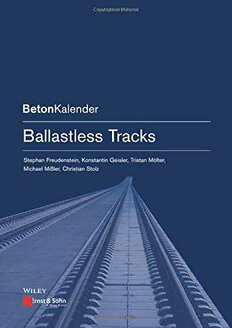
Ballastless Tracks PDF
Preview Ballastless Tracks
Stephan Freudenstein Konstantin Geisler Tristan Mölter Michael Mißler Christian Stolz Ballastless Tracks Stephan Freudenstein, Konstantin Geisler, Tristan Mölter, Michael Mißler, Christian Stolz Ballastless Tracks TheAuthors Dipl.-Ing.ChristianStolz DBNetzAG Univ.-Prof.Dr.-Ing.StephanFreudenstein TrackTechnologyManagement TechnicalUniversityofMunich ChairandInstituteofRoad,RailwayandAirfield Theodor-Heuss-Allee7 60486FrankfurtontheMain,Germany Construction Baumbachstr.7 TheEditorsofBeton-Kalender 81245Munich,Germany Prof.Dipl.-Ing.Dr.-Ing.KonradBergmeister Dr.-Ing.KonstantinGeisler ingwien.atengineeringgmbh TechnicalUniversityofMunich Rotenturmstr.1 ChairandInstituteofRoad,RailwayandAirfield 1010Vienna,Austria Construction Baumbachstr.7 Prof.Dr.-Ing.FrankFingerloos 81245Munich,Germany GermanSocietyforConcreteandConstructionTechnology Kurfürstenstr.129 Dipl.-Ing.TristanMölter 10785Berlin,Germany DBNetzAG TrackTechnologyManagement Prof.Dr.-Ing.Dr.h.c.mult.Johann-DietrichWörner StructuralEngineering ESA-EuropeanSpaceAgency Richelstraße3 Headquarters 80634München,Germany 8-10,rueMarioNikis 75738Pariscedex15,France Dipl.-Ing.MichaelMißler DBNetzAG TrackTechnologyManagement Theodor-Heuss-Allee7 60486FrankfurtontheMain,Germany www.fahrweg.dbnetze.com/fahrweg-en/start TheoriginalGermantextispublishedinBeton-Kalender2015,ISBN978-3-433-03073-8andtitled“FesteFahrbahnin Betonbauweise”.Thisisthetranslatedandrevisedversion. Coverphoto:BallastlessTrackSystem“FesteFahrbahnBögl” Photocredit:ChairandInstituteofRoad,RailwayandAirfieldConstructionoftheTechnicalUniversityofMunich,Germany LibraryofCongressCardNo.:appliedfor BritishLibraryCataloguing-in-PublicationData AcataloguerecordforthisbookisavailablefromtheBritishLibrary. BibliographicinformationpublishedbytheDeutscheNationalbibliothek TheDeutscheNationalbibliothekliststhispublicationintheDeutscheNationalbibliografie;detailedbibliographicdataare availableontheInternetat<http://dnb.d-nb.de>. 2018WilhelmErnst&Sohn,VerlagfürArchitekturundtechnischeWissenschaftenGmbH&Co.KG,Rotherstraße21, 10245Berlin,Germany Allrightsreserved(includingthoseoftranslationintootherlanguages).Nopartofthisbookmaybereproducedinany form–byphotoprinting,microfilm,oranyothermeans–nortransmittedortranslatedintoamachinelanguagewithout writtenpermissionfromthepublishers.Registerednames,trademarks,etc.usedinthisbook,evenwhennotspecifically markedassuch,arenottobeconsideredunprotectedbylaw. CoverDesign:HansBaltzer,Berlin,Germany Typesetting:ThomsonDigital,Noida,India PrintingandBinding: PrintedintheFederalRepublicofGermany. Printedonacid-freepaper PrintISBN:978-3-433-02993-0 ePDFISBN:978-3-433-60690-2 ePubISBN:978-3-433-60691-9 eMobiISBN:978-3-433-60689-6 oBookISBN:978-3-433-60688-9 V Table of Contents Editorial IX ................................................................................................................... Abouttheauthors XI ............................................................................................... 1 Introductionandstateoftheart 1 ....................................................................... 1.1 Introductorywordsanddefinition 1 ................................................................. 1.2 Comparisonbetweenballastedtrackandballastlesstrack 1 ................... 1.3 BasicballastlesstracktypesinGermany–thestateoftheart 3 ........... 1.3.1 DevelopmentsinGermany 4 ............................................................................... 1.3.2 Sleeperframeworkoncontinuouslyreinforcedslab 5 ............................... 1.3.3 Continuouslyreinforcedslabwithdiscreterailseats 7 .............................. 1.3.4 Precastconcreteslabs 7 ......................................................................................... 1.3.5 Specialsystemsfortunnelsandbridges 9 ...................................................... 1.3.6 Furtherdevelopments 9 ........................................................................................ 1.3.7 Conclusion 11 ............................................................................................................. 1.4 Ballastlesstracksystemsanddevelopmentsinother countries(examples) 11 ........................................................................................... References 15 ............................................................................................................... 2 Design 17 ....................................................................................................................... 2.1 Basicprinciples 17 ..................................................................................................... 2.1.1 Regulations 17 ............................................................................................................. 2.1.2 Basicloadingassumptions 18 ................................................................................ 2.2 Materialparameters–assumptions 19 .............................................................. 2.2.1 Subsoil 19 ...................................................................................................................... 2.2.2 Unboundbaselayer 20 ............................................................................................ 2.2.3 Baselayerwithhydraulicbinder 21 .................................................................... 2.2.4 Slab 23 ............................................................................................................................ 2.3 Calculations 24 ........................................................................................................... 2.3.1 General 24 .................................................................................................................... 2.3.2 Calculatingtheindividualrailseatloads 24 ..................................................... 2.3.3 Calculatingbendingstressesinasystemwithcontinuously supportedtrackpanel 28 ......................................................................................... 2.3.4 Systemwithindividualrailseats 28 ..................................................................... 2.3.5 Examplecalculation 32 ............................................................................................ 2.4 Furtherconsiderations 35 ....................................................................................... 2.4.1 Intermediatelayers 35 .............................................................................................. 2.4.2 Temperatureeffects 35 ............................................................................................ 2.4.3 Finiteelementmethod(FEM) 36 ......................................................................... References 37 ............................................................................................................... 3 Developingaballastlesstrack 39 ............................................................................ 3.1 General 39 .................................................................................................................... 3.2 Laboratorytests 40 .................................................................................................... VI TableofContents 3.2.1 Railfasteningtest 40 ................................................................................................. 3.2.2 Testingelasticcomponents 41 .............................................................................. 3.2.3 Testsontensionclamps 42 .................................................................................... 3.3 Lateralforcesanalysis 42 ......................................................................................... References 43 ............................................................................................................... 4 Ballastlesstrackonbridges 45 ................................................................................. 4.1 Introductionandhistory 45 ................................................................................... 4.1.1 Requirementsforballastlesstrackonbridges 45 ........................................... 4.1.2 System-finding 45 ...................................................................................................... 4.1.2.1 Geometricrestraints 47 ........................................................................................... 4.1.2.2 Acoustics 48 ................................................................................................................. 4.1.2.3 Design 48 ...................................................................................................................... 4.1.3 Systemtrialsandimplicationsforlaterinstallation 49 ................................ 4.1.4 Measurementsduringsystemtrials 50 ............................................................... 4.1.4.1 Brakingtests 50 .......................................................................................................... 4.1.4.2 Acousticpropertiesafterinstallingaresilientmat 50 .................................. 4.1.4.3 Deflectionoftheslab 51 .......................................................................................... 4.1.4.4 Summaryofsystemtrials 51 .................................................................................. 4.1.5 Regulationsandplanningguidanceforlayingballastless trackonbridges 51 .................................................................................................... 4.1.6 TheCologne–Rhine/MainandNuremberg–Ingolstadt lines 51 ........................................................................................................................... 4.1.7 VDE8–newformsofbridgeconstruction 52 ............................................... 4.2 Systemsforballastlesstrackonbridges 53 ....................................................... 4.2.1 Theprinciplebehindnon-ballastedballastlesstrackon longbridges 53 ............................................................................................................ 4.2.2 Ballastlesstrackcomponentsonlongbridges 54 ........................................... 4.2.2.1 Railseats 54 ................................................................................................................. 4.2.2.2 Slab 56 ............................................................................................................................ 4.2.2.3 Camplate 56 ................................................................................................................ 4.2.2.4 Separatinglayer 57 .................................................................................................... 4.2.2.5 Protectiveconcrete 58 .............................................................................................. 4.2.3 Ballastlesstrackonshortbridges 58 ................................................................... 4.2.4 Ballastlesstrackonlongbridges 59 ..................................................................... 4.2.5 Thebridgeareasofballastlesstracks 61 ............................................................ 4.2.6 Endanchorage 62 ...................................................................................................... 4.3 Thechallengingtransitionzone 62 ..................................................................... 4.3.1 General 62 .................................................................................................................... 4.3.2 Theupperandlowersystemlevels 62 ............................................................... 4.3.3 Interactionofsuperstructureandbridge 63 .................................................... 4.3.4 Generalactionsanddeformationsatbridgeends 64 .................................... 4.3.5 Summaryofactions 66 ............................................................................................ 4.3.6 Supplementaryprovisionsforballastlesstrackonbridges andanalysis 66 ............................................................................................................ 4.3.7 Measuresforcomplyingwithlimitvalues 68 .................................................. TableofContents VII 4.3.8 Summary,consequencesandoutlook 69 .......................................................... References 70 ............................................................................................................... 5 Selectedtopics 73 ....................................................................................................... 5.1 Additionalmaintenancerequirementstobeconsidered inthedesign 73 .......................................................................................................... 5.2 SwitchesinslabtrackintheDeutscheBahnnetwork 73 ............................ 5.3 Slabtrackmaintenance 76 ...................................................................................... 5.4 Inspections 76 ............................................................................................................. 5.4.1 General 76 .................................................................................................................... 5.4.2 Crackingandopenjoints 77 .................................................................................. 5.4.3 Anchorsforfixingsleepers 78 ............................................................................... 5.4.4 Looseningofsleepers 78 ......................................................................................... 5.4.5 Additionalinspections 79 ....................................................................................... 5.5 Slabtrackrepairs 79 .................................................................................................. 5.5.1 Realexamplesofrepairs 79 .................................................................................... 5.5.2 Renewingrailsupports 79 ...................................................................................... 5.5.3 Repairinganchorbolts 80 ....................................................................................... 5.5.4 Dealingwithsettlement 80 ..................................................................................... 5.5.5 Defectivesoundabsorptionelements 80 ........................................................... 5.6 Drainage 81 .................................................................................................................. 5.6.1 General 81 .................................................................................................................... 5.6.2 Drainingsurfacewater 81 ....................................................................................... 5.6.3 Centraldrainage 81 ................................................................................................... 5.6.4 Stripbetweentracks 81 ............................................................................................ 5.6.5 Covertosidesofslabtrack 82 .............................................................................. 5.7 Transitions 82 ............................................................................................................. 5.7.1 General 82 .................................................................................................................... 5.7.2 Transitionsinsubstructureandpermanentway 82 ...................................... 5.7.3 Weldingandinsulatedrailjoints 83 ................................................................... 5.7.4 Transitionsbetweenbridges/tunnelsandearthworks 83 ............................ 5.7.5 Transitionsbetweenslabandballastedtrack 83 ............................................ 5.7.6 Transitionsbetweendifferenttypesofslabtrack 84 ..................................... 5.8 Accessibilityforroadvehicles 84 ......................................................................... 5.8.1 General 84 .................................................................................................................... 5.8.2 Designingforroadvehicles 84 .............................................................................. 5.8.3 Designingforroadvehicleloads 85 .................................................................... 5.9 Soundabsorptionelements 86 .............................................................................. 5.9.1 General 86 .................................................................................................................... 5.9.2 Constructionandacousticrequirements 86 .................................................... 5.9.3 Specialrequirementsformaterialsandconstruction 86 ............................. References 87 ............................................................................................................... Index 89 ......................................................................................................................... IX Editorial The Concrete Yearbook is a very important source of information for engineers involvedintheplanning,design,analysisandconstructionofconcretestructures.It is published on a yearly basis and offers chapters devoted to various, highly topical subjects. Every chapter provides extensive, up-to-date information written by renowned experts in the areas concerned. The subjects change every year and may return in later years for an updated treatment. This publication strategy guarantees that not only is the latest knowledge presented, but that the choice of topics itself meets readers’ demands for up-to-date news. For decades, the themes chosen have been treated in such a way that, on the one hand, the reader gets background information and, on the other, becomes familiar withthepracticalexperience,methodsandrulesneededtoputthisknowledgeinto practice.Forpractisingengineers,thisisanoptimumcombination.Inordertofind adequate solutions for the wide scope of everyday orspecial problems,engineering practice requires knowledge of the rules and recommendations as well as an understanding of the theories or assumptions behind them. Duringthe history of the Concrete Yearbook,aninteresting development hastaken place. In the early editions, themes of interest were chosen on an ad hoc basis. Meanwhile,however,thebuildingindustryhasgonethrougharemarkableevolution. Whereas in the past attention focused predominantly on matters concerning structural safety and serviceability, nowadays there is an increasing awareness of our responsibility with regard to society in a broader sense. This is reflected, for example,inthewishtoavoidproblemsrelatedtothelimiteddurabilityofstructures. Expensive repairs to structures have been, and unfortunately still are, necessary because in the past our awareness of the deterioration processes affecting concrete andreinforcingsteelwasinadequate.Therefore,structuraldesignshouldnowfocus on building structures with sufficient reliability and serviceability for a specified periodoftime,withoutsubstantialmaintenancecosts.Moreover,weareconfronted byalegacyofolderstructuresthatmustbeassessedwithregardtotheirsuitabilityto carrysafelythe increasedloadsoftenapplied tothemtoday.Inthisrespect,several aspectsofstructuralengineeringhavetobeconsideredinaninterrelatedway,suchas risk, functionality, serviceability, deterioration processes, strengthening techniques, monitoring, dismantlement, adaptability and recycling of structures and structural materialsplustheintroductionofmodernhigh-performancematerials.Thesignifi canceofsustainabilityhasalsobeenrecognized.Thismustbeaddedtotheawareness thatdesignshouldfocusnotjustonindividualstructuresandtheirservicelives,but on their function in a wider context as well, i.e. harmony with their environment, acceptance by society, responsible use of resources, low energy consumption and economy. Construction processes must also become cleaner, cause less environ mental impact and pollution. TheeditorsoftheConcreteYearbookhaveclearlyrecognizedtheseandothertrends and now offer a selection of coherent subjects that reside under the common ‘umbrella’ofabroadersocietaldevelopmentofgreatrelevance.Inordertobeableto X Editorial copewiththecorrespondingchallenges,thereadercanfindinformationonprogress intechnology,theoreticalmethods,newresearchfindings,newideasondesignand construction,developmentsinproductionandassessmentandconservationstrate gies.ThecurrentselectionoftopicsandthewaytheyaretreatedmakestheConcrete Yearbookasplendidopportunityforengineerstofindoutaboutandstayabreastof developments in engineering knowledge, practical experience and concepts in the field of the design of concrete structures on an international level. Prof. Dr. Ir. Dr.-Ing. h. c. Joost Walraven, TU Delft Honorary president of the international concrete federation fib
